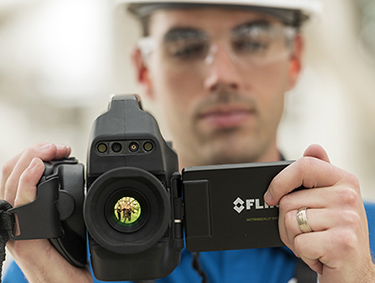Leveraging Technologies to Reduce Emissions
As part of our commitment to managing air emissions, we have the following air monitoring programs:
-
Valero's Duvas DV3000, a real-time mobile air quality monitoring system, provides instant air quality screenings. The vehicle-mounted DV3000 is a gas analyzer that uses ultraviolet spectroscopy to identify and qualify up to 14 different gases, including benzene, SO2 and NOx, at low part-per-billion levels.
-
Continuous Emissions Monitoring Systems (CEMS) are placed in the outlet stacks of certain fired equipment (boilers and heaters) as well as process vents like the Fluid Catalytic Cracking Unit (FCCU). CEMS continuously measure the concentration of compounds, such as NOx, SO2, exiting the stack to confirm operations are within permitted limits.
-
Continuous Flare Monitoring Systems are installed on flares to measure the amount of process gases routed to the flare for destruction and track operational parameters to confirm the flare is operating properly.
-
Stack Testing is conducted periodically on equipment that does not require continuous emissions monitoring to confirm it is operating properly and within permitted limits.
-
Leak Detecting and Repair (LDAR) ensure all of our operating sites comply with the EPA Air Quality regulations for reducing fugitive emissions. Inspections are conducted on a routine basis. Leaks identified are fixed and re-monitored to confirm repairs were effective.
-
Routine Optical Gas Imaging (OGI) Inspection as of storage tanks, wastewater treatment operations and other equipment are performed using OGI cameras equipped with infrared technology capable of detecting VOC leaks that are visible to the naked eye.
-
Unit Battery Limits Monitors placed around the perimeter of refinery process units continuously measure for target compounds. These stationary air monitors serve as an early warning system if elevated concentrations are detected.
-
Personal H2S Monitors are required to be worn by refinery personnel while in and around process units, continuously measuring for H2S and sounding an alarm and recording in the event elevated H2S is detected.
-
Five-Gas Monitors are routinely used by personnel within the refinery for measuring H2S, SO2, CO, Oxygen and lower explosive limit (LEL) levels for safety purposes and also as early detection to identify and correct issues that could impact ambient air quality.
-
Fenceline Benzene Monitors are located around a number of our refineries at designated intervals to collect composite samples. Additionally, stationary analyzers that detect total VOCs or specific compounds, such as benzene, are deployed at certain sites in areas at or inside the fenceline to allow for advanced notification of elevated concentrations.
